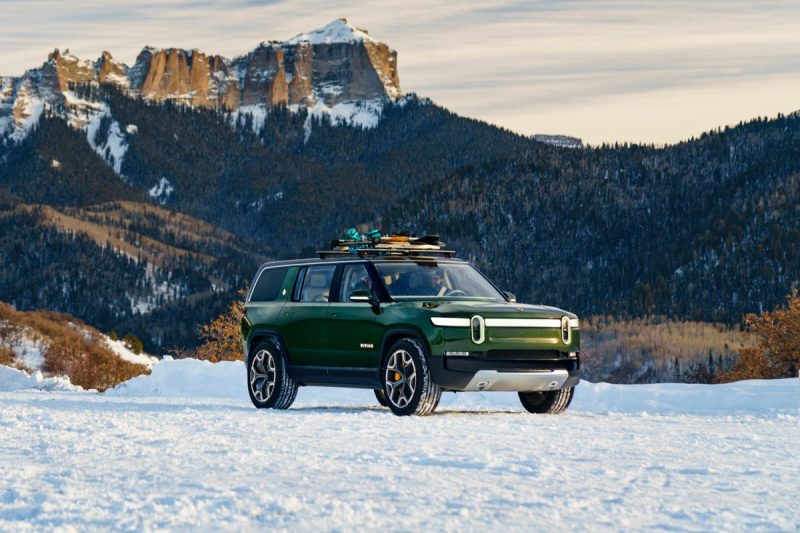An August 11, Q2 earnings call with Rivian CEO RJ Scaringe revealed the brand new auto manufacturer lost $1.7 billion in the last three months and expects to lose $5.4 billion total in 2022.
While this might have investors running for the hills in other markets, it’s normal for a budding auto manufacturer. The auto industry presents one of the steepest barriers to entry for any new business. The truck startup is trying to follow in Tesla’s very large footprints to establish itself as the second mass-market American automotive company to establish a presence since Chrysler took root in the 1920s. That’s a big dream, but there are even bigger believers in Rivian. With deep pockets, massive investors, an innovative and attractive product, and plans through 2025, Rivian has a shot at sticking.

Enthusiasm and demand for Rivian’s maiden product, the five-seat R1T Launch Edition pickup truck is still very high, despite an initial MSRP of $67,500. Demand for electric SUVs and trucks is increasing, Rivian said, claiming a backlog of preorders that reached 98,000 at the end of June.
Still, it will have to deliver more than the 4,401 vehicles across the R1T, R1S, and EDV 700 (Amazon electric van) lines in the second quarter. This will be in spite of supply chain shortages and snags, Scaringe added, reiterating the EV company’s annual production forecast of 25,000 units in 2022. This anticipates rolling out a second shift of vehicle assembly to its Illinois plant by the end of the third quarter.
“Our key focus remains ramping our normal facility to its full 150,000 units of installed capacity. While we continue to manage supply chain constraints, we are encouraged by the progress we are making, which is important for us to be able to add a second shift for general assembly towards the end of this quarter,” Scaringe said.
Is Rivian in trouble?
Building ten of thousands of vehicles requires investing billions of dollars in equipment and employees. Entire factories have to be outfitted from scratch, and supply chains need to be established and refined. While the assembly line runs, engineers upstairs require time and money to design vehicle systems, from acceleration to exhaust. This has provided predictable issues for the budding manufacturer.
Rivian’s executive vice president and former Tesla executive Charly Mwangi, who helped fire up the maker’s manufacturing process, left the company. The company laid off 6% of its workforce in July in response to inflationary pressures and rising interest rates, which also led to raising truck prices. Reassuring small investors are Rivian’s reaction to these challenges and the big boys who have billions on the line for Rivian.
In a letter to investors, Scaringe apologized and retracted the price hike. While this slices into profits, its largest patrons can likely afford to receive the financial blow. Amazon owns 18% of Rivian and Ford invested $500 million in the electric truck firm in 2019, and a former executives joined Rivian’s board of directors (only to leave in 2021). Recent additions to the board include Mwangi replacement, former Magna International executive Frank Klein, who took over as chief operations chief in June, and Harald Kroeger, a former Bosch and Daimler executive, who was just announced as a new board member.
In addition to the noted leadership, engineering and design talent, Rivian’s believers point to construction plans for a $5 billion facility in Georgia that it says will be able to produce 400,000 vehicles a year. There’s also plans for the more affordable R2 model, scheduled to be rolled out in 2025.
Scaringe, predicted that this more economic model will not only cost less, but be more attractive because of green tax credits. As part of the just-passed climate bill’s focus on a sustainable future for the country, new EV buyers will be eligible for a $7,500 tax credit. This only applies, however, to vehicles with an MSRP under $80,000, which does not apply to the R1.
“While many of our R1 configurations won’t meet the bill’s pricing requirements, our R2 product line and associated cell road map are being developed to allow our customers to capture the value of these incentives,” Scaringe said.
In the three-year interim, Rivian will focus on massaging and finding solutions to supply chain issues and production hangups to deliver 25,000 R1 series units by the end of the year. If car construction ramps up successfully, Rivian will continue with significant plans to be a major player in the blossoming EV truck market.



